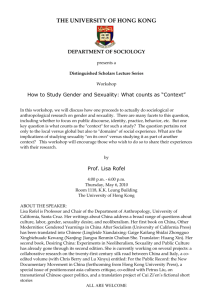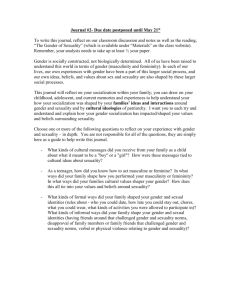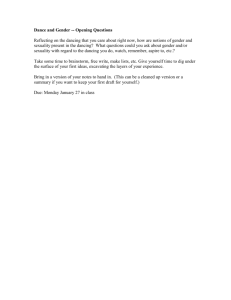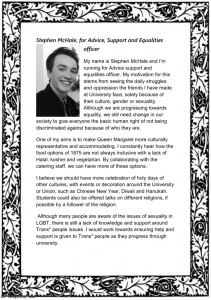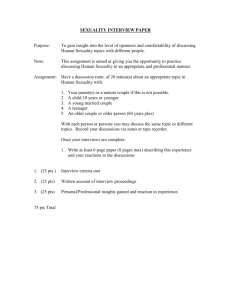PART I The Social Construction of Difference: Race, Class, Gender
advertisement
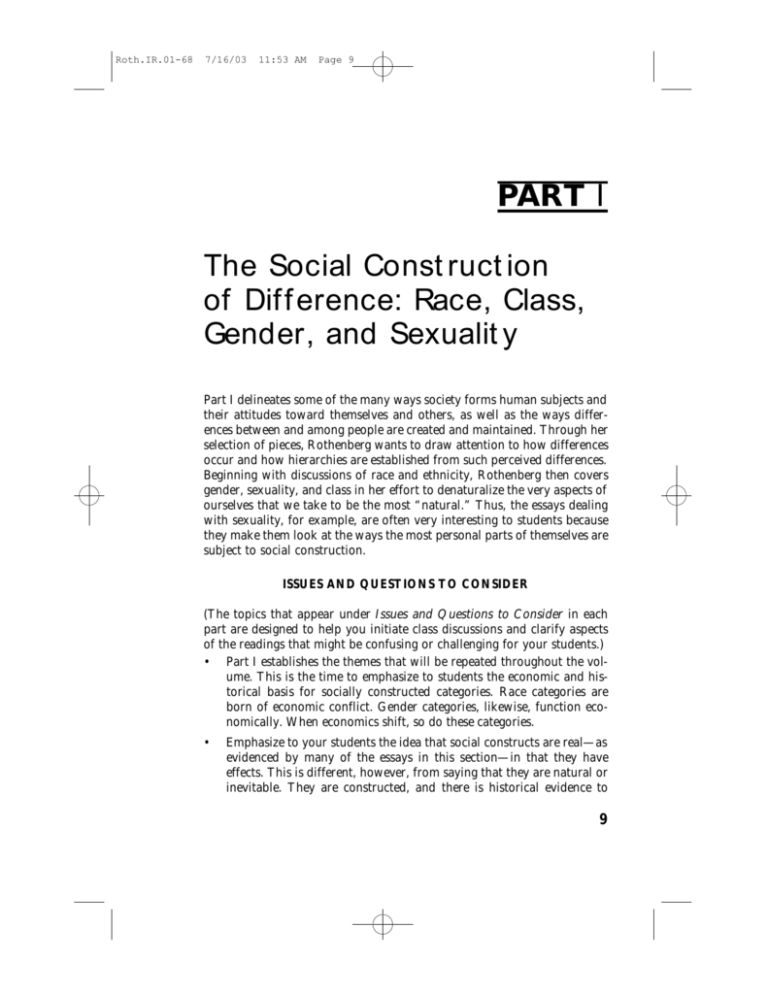
Roth.IR.01-68 7/16/03 11:53 AM Page 9 PART I The Social Const ruct ion of Dif f erence: Race, Class, Gender, and Sexualit y Part I delineates some of the many ways society forms human subjects and their attitudes toward themselves and others, as well as the ways differences between and among people are created and maintained. Through her selection of pieces, Rothenberg wants to draw attention to how differences occur and how hierarchies are established from such perceived differences. Beginning with discussions of race and ethnicity, Rothenberg then covers gender, sexuality, and class in her effort to denaturalize the very aspects of ourselves that we take to be the most “natural.” Thus, the essays dealing with sexuality, for example, are often very interesting to students because they make them look at the ways the most personal parts of themselves are subject to social construction. ISSUES AND QUESTIONS TO CONSIDER (The topics that appear under Issues and Questions to Consider in each part are designed to help you initiate class discussions and clarify aspects of the readings that might be confusing or challenging for your students.) • Part I establishes the themes that will be repeated throughout the volume. This is the time to emphasize to students the economic and historical basis for socially constructed categories. Race categories are born of economic conflict. Gender categories, likewise, function economically. When economics shift, so do these categories. • Emphasize to your students the idea that social constructs are real—as evidenced by many of the essays in this section—in that they have effects. This is different, however, from saying that they are natural or inevitable. They are constructed, and there is historical evidence to 9 Roth.IR.01-68 10 7/16/03 11:53 AM Page 10 Part I prove it. As Judith Lorber says in “‘Night to His Day’: The Social Construction of Gender,” “Whatever genes, hormones, and biological evolution contribute to human social institutions is materially as well as qualitatively transformed by social practices. Every social institution has a material base, but culture and social practices transform that base into something with qualitatively different patterns and constraints.” You might discuss what she means by this. • Many students want to see differences as necessary and useful defining characteristics of human beings. To discuss issues of race and ethnicity, gender, sexuality, and class as social constructs, with no inherently “natural” meanings, is often unsettling to students who may desperately want to emphasize differences between men and women or between other groups. Students often feel that if differences are discussed and evaluated in class, they are being asked to eliminate them altogether—an impossibility in our current society. But as a point of departure for discussion, take a topic from Part I, such as race, and talk about what society would be like if no racial differences existed. What would such a society look like? Such an exercise is useful for making distinctions between the idea that no differences should exist and the idea that differences in this culture represent the ways various people are defined hierarchically depending on the color of their skin, their ethnic background, their gender, their sexuality, or their class. In other words, differences do exist, and the point is not necessarily that there shouldn’t, for example, be any distinctions between men and women; but rather that the ways each gender is valued in this culture can be extremely unfair and even dangerous. A useful way to end this discussion would be to bring in Jean Baker Miller’s piece, “Domination and Subordination.” Who is dominant? Who is subordinate? Why? • In “The Ethics of Living Jim Crow,” Richard Wright describes what it was like to grow up under laws and attitudes that assumed black people and white people were two different species, with whites being inherently more valuable than blacks. Although the laws were overturned during the civil rights struggles of the fifties and sixties, attitudes and ideologies are harder to deal with. Drawing on the work of Michael Omi, Howard Winant, and Pem Davidson Buck, how have things changed? How are they the same? How does the history of slavery and Jim Crow affect the ways African American identities are socially constructed in our contemporary society? To what end? • Ask students to consider questions of history. In current debates, recent immigrants—especially “illegal” ones—have been demonized by everyone from politicians and the mass media to people who have benefited Roth.IR.01-68 7/16/03 11:53 AM Page 11 The Social Construction of Difference 11 from their labor. Karen Brodkin’s piece provides an overview of the history and immigration patterns of Jews in America, and it offers a perspective on recent discussions of the “problems” of immigration. How do students view this history? How does it affect their understanding of contemporary approaches to immigration? What do they make of the fact that “white” groups were discriminated against in the past as “others”? How does an understanding of history facilitate one’s analysis of current issues or problems? • What are the multiple ways gender is socially constructed? What are the stereotypes surrounding femininity? Masculinity? What happens when someone does not fit these norms? What is the difference between “sex” and “gender” (Lorber, Hubbard, Kimmel)? • What happens to one’s view of sexuality when one does not see it as “natural”? How does that influence or change attitudes toward homosexuality or bisexuality, for example? If heterosexuality is a social construct, what about procreation? What role does biology play in the construction and maintenance of sexuality? What happens when one disconnects sexuality from gender? When one stops seeing men as inherently sexual and women as asexual or merely as sexualized objects (Hubbard, Katz, Kimmel)? • What happens to one’s view of “disability” when one stops defining it as a “condition,” but rather sees it also as being socially constructed? How has the language of disability permeated our culture to such an extent that it is used consciously and unconsciously to dismiss or denigrate the contributions of various constituencies in U.S. society? In what way does such language encourage or facilitate inequality, as Douglas Baynton puts it in his piece? And how does such language discount disabled people? • In “Deconstructing the Underclass,” Herbert Gans discusses how the public’s perception of class is shaped by the terms we use to describe it. How are poor or working-class people viewed in this society? How does the concept of nature tie into who belongs in what class? What are the pitfalls of thinking about this country as being either “classless” or as having a huge middle class to which everyone belongs? ASSIGNMENTS Generating Ideas/Small-Group Discussions ASSIGNMENT 1. In almost all of the essays in Part I, race, gender, sexuality, and class are analyzed as, to use Omi and Winant’s term, “pre-eminently Roth.IR.01-68 12 7/16/03 11:53 AM Page 12 Part I sociohistorical concept[s]” (I, 1). That is, things “are given concrete expression by the specific social relations and historical context in which they are embedded.” In your journal, take a page to discuss an aspect of race, gender, sexuality, or class as a “sociohistorical concept.” How is your view of race or ethnicity different from the views held by people during the period Richard Wright describes in his piece “The Ethics of Living Jim Crow” (I, 2)? How are gender relations different now than in your parents’ time? How does the current configuration of the government affect the way class is talked about? When you consider answers to these questions, avoid thinking in terms of “progress”—that is, that “things are better now than in the past.” The point of addressing these questions in your journal is to get you to think about social relations as inherently complicated processes that certainly change over time, but don’t always change for the better. ASSIGNMENT 2. At the beginning of “Racial Formations” (I, 1), Omi and Winant describe the case of Susie Guillory Phipps, who tried to sue the Louisiana Bureau of Vital Records in order “to change her racial classification from black to white.” As the authors point out, this case brings to the fore questions concerning the definition of race and how people are racially marked. In a small group, discuss the ways each group member is “marked” racially. What, for example, is your whiteness composed of, if that is how you define yourself? Your blackness? Your brownness? How is ethnicity “marked” in this culture? What are the implications of such marking for society? After you have spent several minutes on this task, spend a few more writing a page discussing what you learned about yourself and others. Evaluate yourself as a “raced” person. How do you fit into a culture that insists on marking its members? ASSIGNMENT 3. Karen Brodkin (I, 4) describes her “surprise” that immigrant workers, such as Jews, were not always considered “white,” since she grew up in a community that did not mark her as “ethnic.” What do you make of her generational discussion of the ways immigrants became “white”? What does this essay say about whiteness? About the racialization of immigration? Why are contemporary immigrants seen as “dark,” when many, in fact, are “white”? ASSIGNMENT 4. On the chalkboard, your instructor will write down four categories: FEMALE/MALE, WOMAN/MAN. These are meant to make a distinction between categories of “sex” and “gender.” Spend several minutes as a class listing the stereotypes or attributes of these beings under each category. What can you come up with? What do these stereotypes show about the ways people view sex and gender? Are these cate- Roth.IR.01-68 7/16/03 11:53 AM Page 13 The Social Construction of Difference 13 gories set in stone? How are various attributes valued or devalued in our society? Why are they valued and devalued? Also think about how quickly you were able to come up with these stereotypes. What do you think this says about the staying power of stereotypes in this society? You can also do a similar exercise with class and ability: Divide the board up into four categories, POOR/WORKING CLASS/MIDDLE CLASS/UPPER CLASS, or into two categories, ABLED/DISABLED. How are these categories valued or devalued in this culture? What attributes are assigned to people in these categories? How did these attributes come into being, do you think? ASSIGNMENT 5. In “The Invention of Heterosexuality” (I, 7), Jonathan Ned Katz not only highlights the ways heterosexuality is socially constructed but also historicizes the process by which such construction occurs. You may be challenged by Katz’s assertion that one is not born but made heterosexual, which should lead to both lively discussions and interesting writing. After discussing the essay in class—and perhaps pairing it with Lorber’s piece (I, 5), Hubbard’s “The Social Construction of Sexuality” (I, 6), and Kimmel’s “Masculinity as Homophobia” (I, 8)— write a one- to two-page response/critique of Katz’s article in your journal or as a homework assignment. What new ideas did you learn from the essay? Have you ever thought that something like sexuality could be socially constructed? In your own life, how have you noticed sexuality or gender as being constructed? How does homophobia function to regulate so-called “normal” sexual and gender identities? As a class, spend a week documenting ways that gender and sexuality are constructed. At the end of the week, reconvene and discuss everyone’s findings as a class. Writing Assignments ASSIGNMENT 6. Read Jean Baker Miller’s “Domination and Subordination” (I, 11) and consider the questions she poses at the beginning of the piece: When does the engagement of difference stimulate the development and the enhancement of both parties to the engagement? And, conversely, when does such a confrontation with difference have negative effects: When does it lead to great difficulty, deterioration, and distortion and to some of the worst forms of degradation, terror, and violence—both for individuals and for groups—that human beings can experience? Pick two hypothetical instances of what she describes and discuss them. When does one learn from encountering difference? When does such an encounter Roth.IR.01-68 14 7/16/03 11:53 AM Page 14 Part I lead to difficulty? Try to keep your essay focused on the institutional or systemic. You might look at issues surrounding bilingual education in schools, the history of mandatory or voluntary busing, women in the workplace, or the living-wage movement (where a livable income would replace the minimum wage). ASSIGNMENT 7. Read “Racial Formations” (I, 1) and “The Ethics of Living Jim Crow” (I, 2), “Constructing Race, Creating White Privilege” (I, 3), and/or “How Jews Became White Folks” (I, 4). How do Wright’s, Buck’s, and Brodkin’s pieces illustrate what Omi and Winant are writing about? Focus your essay on two or three aspects where each piece echoes the other. For example, how does Wright describe his early process of “racialization” (Omi and Winant) as a boy living in Arkansas? How does Buck integrate discussions of laws regarding race and “race mixing” into her analysis of the construction of whiteness? What does Brodkin say about the linkage of whiteness and middle class-ness? How does Wright describe his racial consciousness as a “sociohistorical concept” (Omi and Winant)? Instead of the Wright, Buck, or Brodkin pieces, you can also use an article from Part V and talk about how people from other ethnic groups undergo similar racializing processes. ASSIGNMENT 8. Read Judith Lorber’s “‘Night to His Day’: The Social Construction of Gender” (I, 5). Take a moment to think about the clothes you are wearing and the ways you dress yourself. How does Lorber’s piece help you analyze the ways you construct yourself? How do clothing fashions aid in the social construction of gender? What does a woman or man say about herself or himself with various pieces of clothing? Write an essay in which you explore these issues. Research/Analysis Projects ASSIGNMENT 9. From your journal or homework assignments on Katz’s “The Invention of Heterosexuality” (I, 7), look at a particular practice or phenomenon (homosexuality, heterosexuality, bisexuality, gendered fashions, particular words—“straight,” “queer”—or phrases, behaviors, etc.) and formulate a thesis statement or argument about it. How is this practice or phenomenon viewed by society? Why? What effect does this point of view have on the people who live their lives in this way? An interesting research project might be for you to look at a history of sexuality in America and examine a practice in a historical and contextual frame. If you are heterosexual, how did you come to act the way you do? What in the culture (films, ads, TV shows, books, Valentine’s Day, etc.) presents a model for your way of being? In other Roth.IR.01-68 7/16/03 11:53 AM Page 15 The Social Construction of Difference 15 words, place a contemporary sexual role or gendered behavior in the past in context, and talk about how the past construction impacts contemporary constructions of your topic. ASSIGNMENT 10. Omi and Winant primarily discuss the social construction of African Americans as black, and what that construction has meant historically as well as currently. Take another group—Latinos, Asians, or Native Americans, for instance—and do a similar analysis. Research the group’s history in the United States. What were early constructions of this group’s racial/ethnic attributes? How have people from several countries or regions been collapsed into one general category (e.g. “Asians,” which stands in for people who are from a wide range of places such as China, Japan, Korea, Thailand, India, and Pakistan)? How does this impact the way these people are viewed by the dominant society? How does this lumping erase essential differences between people’s distinct cultures? What have these groups become in contemporary parlance? How are they constructed in everyday life by the media, the government, and schools? Brodkin’s “How Jews Became White Folks” (I, 4) and Buck’s “Constructing Race, Creating White Privilege” (I, 3) are useful essays to draw from here. ASSIGNMENT 11. While reading Lorber’s article (I, 5), pay close attention to her discussion of sports. You might also look at Kimmel’s piece in this part (I, 8), and Sabo’s and Jordan’s pieces in Part V. With the fairly recent addition of the Women’s National Basketball Association to the summer sports lineup and the success of women’s soccer teams, how do male and female athletes compare? How are they constructed in the media? To do this project, you might survey several issues of sports magazines, such as Sports Illustrated, and watch several days of ESPN, Fox Sports, and other sports programming. What do these mass-mediated outlets do in their constructions of femininity and masculinity? Of sexuality? Of race and ethnicity? ASSIGNMENT 12. After reading Gans’s article, “Deconstructing the Underclass” (I, 10) research and discuss how poor people are portrayed in contemporary culture. You might want to refer to the two articles by Gregory Mantsios (Parts II and VII), in particular, “Media Magic: Making Class Invisible” (VII, 112). Survey the news media or popular culture for ways that the poor are represented. How do such portrayals affect people’s vision of the poor and of themselves? Are there any mass-media representations that do not fall into easy stereotyping? If so, what are they and how are their representations different from the norm? You might compare and contrast a couple of different constructions of the poor or working classes to illustrate your arguments. Roth.IR.01-68 16 7/16/03 11:53 AM Page 16 Part I ASSIGNMENT 13. After reading “Domination and Subordination” by Jean Baker Miller (I, 11), write an essay in which you analyze the concept of the “dominant group.” You might also refer to Buck’s (I, 3) and Brodkin’s (I, 4) essays on whiteness, Katz’s essay on heterosexuality (I, 7), Kimmel’s piece on masculinity (I, 8), Gans’s article on class (I, 10), and perhaps incorporate some of Baynton’s observations about the language of ability and disability (I, 9). How does dominance operate in U.S. society? What happens when you make visible the dominant groups? Is it important to understand this concept? Why or why not? What can we gain from understanding how such dominance is constructed and maintained? Make sure to provide specific examples to illustrate your points. RECOMMENDED MEDIA • • • • • Show Spike Lee’s Do the Right Thing. What is “doing the right thing” for Lee’s character? What do the race relations in this film show about the ways people construct each other through the lens of skin color? How do issues of class play out in the film? In other words, why does Lee’s character keep working in the pizza parlor, even though he is treated as less than human at times? Show American History X and discuss how the film deals with the making of a racist and the unmaking of one. Does the film work? Why or why not? What roles do class and masculinity play in the film? To interrogate issues of the “naturalness” of gender or sexuality, show Paris is Burning or Wigstock. How do these films foreground the constructedness of gender roles and sexuality? How do they contest the “naturalness” of femininity as attached to women and masculinity as attached to men? Show the “Malibu Stacey” episode of The Simpsons. Why does Lisa want to make her own talking Barbie-like doll? What does this episode say about how dolls contribute to gender role construction? With the class, you might also interrogate Grandpa Simpson’s own journey. What is this episode doing with age and ageism? Show the film My Left Foot. Even though this film is set in Britain, how does the story of Christy Brown’s life and how he dealt with his cerebral palsy illustrate Baynton’s points about disability and the language of disability? The film reviews all laud Brown’s “courage” and “determination” in dealing with his disability, yet he was also hard drinking and had an extremely earthy approach to life. How is our society’s penchant for defining disability as “lack” borne out in these reviews? How does this film challenge or uphold our definitions of disability?

